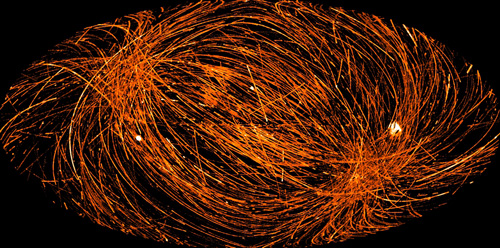The XMM-Newton X-ray observatory slews across the sky as it shifts its gaze from source to source. Now those tracks have been combined for a beautiful glimpse of the X-ray sky.

The XMM-Newton X-ray observatory recorded bright strips of data in between official observations, tracks that now cover 62% of the sky. Some of the brightest sources in the survey include the Vela supernova remnant (the bright white feature at the far right), the Cygnus Loop (far left), Scorpius X-1 (just above the image centre).
A. Read (University of Leicester) / ESA
Time and tide wait for no man. So the XMM-Newton space telescope makes every second count.
The observatory often focuses on a single X-ray source for hours, and sometimes even days at a time. For a faraway quasar or a faint pulsar, it can take that long to collect a couple hundred photons. In between these official observations, the telescope slews across the sky at a rate that leaves any X-ray source in the telescope’s field of view for a mere 15 seconds. Still, that’s enough time to collect a few photons and identify a source where none was known before.
Between 2001 and 2012, 1,200 slews have covered 62% of the X-ray sky, resulting in a beautiful mosaic that combines 73,178 images. Within this mosaic, astronomers had already found some 13,000 sources as of 2011.
Read the latest on the XMM-Newton Slew Survey in the release linked below.
EUROPEAN SPACE AGENCY RELEASE:
Dance of the X-rays
Like car tail lights streaking through a busy city at night, this unique image records over a thousand movements made by ESA’s XMM-Newton space telescope as it shifts its gaze from one X-ray object to another. . . . Read the full press release.
 0
0
Comments
You must be logged in to post a comment.